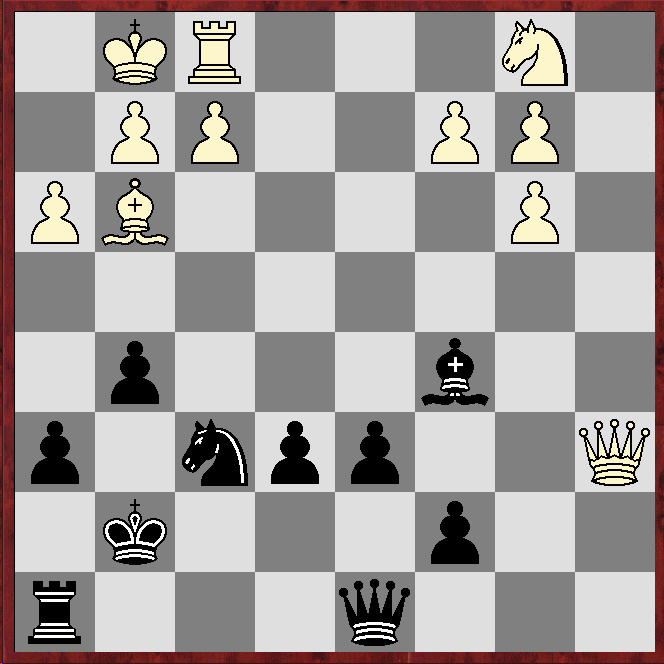Giuoco Piano
1.e4 e5 2.Nf3 Nc6 3.Bc4 Bc5 4.0-0 Nf6 5.d3 d6 6.h3 Na5!? 7.Bb3 Nxb3 8.axb3 a6
*****
*****
*****
*****
Black has the bishop-pair, at least temporarily, but White has a half-open a file and a slight lead in development. Stockfish16 and Komodo14.1 reckon the game is equal.
9.Bg5!?
White could get rid of the bishop-pair with the apparent-novelty 9.Be3, but the text is perhaps more ambitious.
9....h6 10.Bh4 Be6
9....h6 10.Bh4 Be6
The engines reckon 10...g5!? gives Black a slight edge.
11.d4!? exd4 12.Nxd4
12.Qd3!? gives White just about enough compensation for a pawn, according to the engines.
12...g5 13.Nxe6
The engines prefer 13.Bg3 Nxe4 and either 14.Nc3 or 14.b4!?, the point about the latter being 14...Bxb4?? loses to 15.Nxe6 fxe6 16.Qd4.
13...fxe6 14.Bg3 Nxe4 15.Qh5+?!
White should move the king, either to h1 or h2, according to the engines, but Black would have the upper hand.
15...Kf8?
Black has a large advantage after 15...Kd7 as 16.Qf7+ is simply met by 16...Qe7.
16.Qf3+ Nf6 17.Qxb7 Kg7!?
The engines fluctuate between the text and 17...a5.
18.Rxa6 Rxa6 19.Qxa6
*****
*****
*****
*****
Black has pressure against the white king's position, and the white bishop is restricted, but it is the black king that is more exposed. Meanwhile White is a (doubled) pawn up. The engines for quite some time give White a slight edge, but come to call the position more-or-less equal.
19...Rf8 20.Qe2 e5 21.Nc3 Bd4 22.Nd1 Qe8 23.c3 Bb6 24.Ne3 Qf7?!
Probably better is 24...Ne4.
25.c4?!
Much harder to meet is 25.Nc4, eg 25...Ba7 can be answered by 26.Ra1, and after 25...Nh5 26.Bh2 the black bishop virtually has to withdraw at a7 anyway. True, the white rook cannot then take the a file, but the engines reckon 27.b4 gives at least a slight edge.
25...Ne4 26.Bh2 h5!?
This looks risky, but it keeps white pieces off the g4 and h5 squares.
27.Nd1 Nc5?
White gets an initiative after this. Instead 27...Qf5 or 27...Qg6 leaves Black with full compensation for a pawn, according to the engines.
28.b4 Ne6 29.c5 Ba7 30.Qa6 Bb8
 |
| In three moves Black has gone from having an active bishop pressing on the white king's position to having a bishop so passive it is worse than its opposite number |
*****
*****
*****
*****
31.Nc3 Nd4 32.Ne4 Qf5 33.Ng3 Qg6 34.Ne2 Nf5 35.Qd3 Qf6
The engines prefer 35...g4, but give White at least the upper hand.
36.Ng3 Nxg3 37.fxg3?
A major misreading of the coming bishop-and-pawn ending.
37...Qxf1+ 38.Qxf1 Rxf1 39.Kxf1 c6!?
One of several moves that give complete equality, according to the engines.
40.g4!? hxg4 41.hxg4
The engines reckon 41.cxd6 and 41.b5!? maintain complete equality, eg 41.cxd6 Bxd6 42.b5!? cxb5 43.hxg4. Their point is that after the text Black can play 41...d5, which at first they believe gives a slight edge. But Stockfish16 comes to evaluate the position as still equal, while Komodo14.1, although preferring Black, cannot seem to make progress.
41...Kf6 42.Kd2 Kd6 43.Kd3 Kd5 44.cxd6 Bxd6 45.Bg1 Bxb4
 |
| Black has restored material equality, and has a passed pawn, but cannot make progress, according to the engines, who again call the game completely equal |
*****
*****
*****
*****
46.Be3 Be7 47.b3 e4+ 48.Kd2 Bf6 49.Kc2 Ke5 50.Kd2 Bd8 51.Kc2 Kf6 52.Kc3 Ke5 53.Kc4 Be7 54.Kc3 Kd5 55.Kd2 c5!?
Putting another pawn on a dark square, but I do not believe there is any other way to try to make something happen.
56.Kc3 Bf6+ 57.Kd2 Kc6 58.Kc2 Kb5 59.Bd2 Be7 60.Kb2 c4
*****
*****
*****
*****
61.b4?!
Many moves hold the draw easily, including Kc2, Bc1, Be3 and g3. The text may also draw, but makes the position tricky for White.
61...Bf6+
Perhaps 61...Ka4 is a better try, but 62.Kc2 Bxb4 63.Bxg5 is equal, and it is not clear Black can improve. Komodo14.1 likes 62...Bf6, but Stockfish16 reckons 63.b5!? Kxb5 64.Be3 holds, and Komodo14.1 more-or-less agrees that it gives Black only a slight edge.
62.Kc2 Ka4
*****
*****
*****
*****
*****
63.Be1?
White has to be prepared to give up the b pawn, eg 63.b5!? Kxb5 64.Be3, the key to the draw being to maintain the blockade of the e pawn by the bishop and the c pawn by the king. Therefore 63.Be3!? and 63.Bc1 also draw.
63...e3 64.Kd1
This loses, but there is no defence as giving up the b pawn no longer works, eg 64.b5 Kxb5 65.Bg3 Kb4 66.Be1+ c3 67.Bg3 Kc4 transposes to a lost position that arises in the game.
64...c3 65.Kc2 Kxb4 66.Bg3 Kc4 67.Be1
Or 67.Bc7 e2 68.Bg3 Kd4 69.Bf2+ Ke4 70.Bg3 Ke3 71.Be1 Be5, when White is in zugzwang.
67...Be5 68.Kd1 Kd3 69.Kc2 Ke2 0-1




very good endgame,course of determination
ReplyDeleteThanks. I guess I got lucky in the end, but it was worth playing on as I know how difficult it is to hold a 'drawn' ending against a higher-rated opponent
Delete